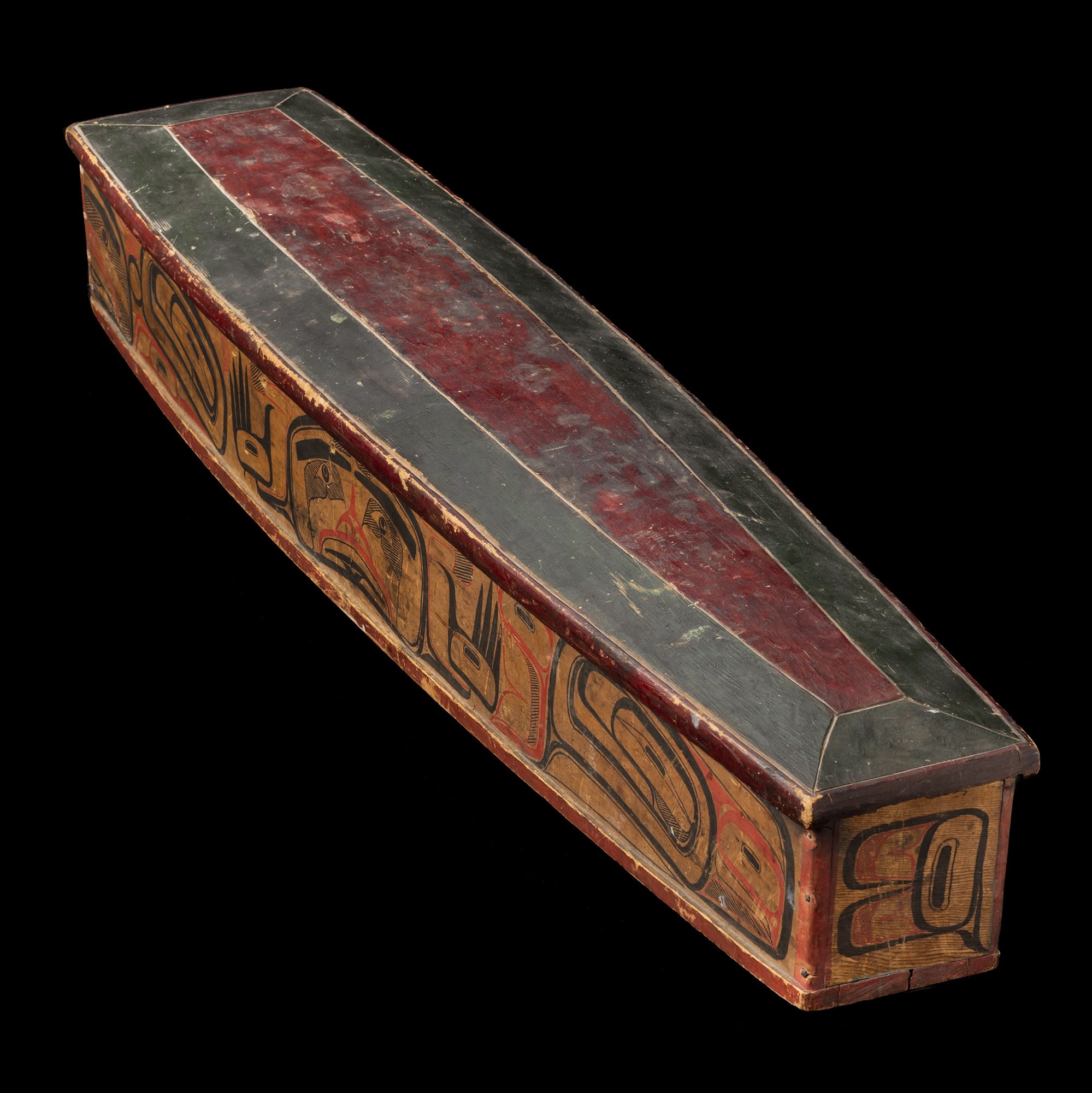Lot 44
Blanket Box, c. 1900-10
wood, pigment, cord, and metal, 6.5 x 52 x 10.5 in (16.5 x 132.1 x 26.7 cm)
Provenance
Alaska on Madison, NYC;
a Prominent Private Collection, British Columbia;
a BC Private Collection.
Purpose-made containers for holding Chilkat robes are unknown on the NW Coast, except for the possibility of this and one other unusual box by the same Heiltsuk artist, commonly known as Captain Carpenter. A prolific artist, Carpenter’s career spanned the late nineteenth and early twentieth centuries, during which time he produced a great number of painted and carved chests and boxes, as well as various types of sculpture, for which he is well known and highly respected. Heiltsuk artists did not weave robes in Chilkat style, but would have acquired them via direct or indirect trade with northern coastal groups.

This container, tapered at one end, is reminiscent of a coffin form, though for its length the shoulder area is too narrow to function well for that purpose. At fifty-two inches long, though, the box is perfectly shaped to contain a Chilkat robe rolled up lengthwise, from side to side. This is the only way to roll such a robe without damaging the warp yarns, which are stiffened with the addition of yellow cedar bark fibers. Once rolled up, the bulk of the robe would be where the weft yarns of the design area give it greater thickness, and the loose ends of the warp yarns that hang below the design, much less bulky, would fit perfectly in the narrow end of the box.
The crowned lid of the box, which fits down over the box sides, is of a type that is often seen on boxes intended for outdoor use (tool boxes, fishing equipment). The minimal flat area in the center of the lid, the angled edges, and the outside lip facilitate the ample coastal rain not puddling on the lid and running down the outside of the box, therefore keeping the contents dry. Traditional flat box tops (see Lot 75) have the lip fitted down the inner edge of the sides, which would enable water to move by capillary action beneath the lid and down into the container. With curving sides and a graceful taper, this lid has a dynamic shape uncommon among related boxes of this practical type.
The painting on the sides of the box is executed in Carpenter’s signature style, recognized by very thin black formlines, broad negative areas, very thin red formlines, and extremely small inner ovoids and eye forms. The interior of the box is painted in the classic blue-green color of the northern coast, derived from native compounds and reserved for use on the most high-status of objects.
Steven C. Brown
Captain Richard Carpenter was a member of the ’Qvuqvayaitxv tribe, born in the Heiltsuk village of ’Qvuzvai in 1841. A member of the Blackfish clan, he was permitted to represent his family’s crest—an eagle (from his mother’s side) over a killer whale (from his father’s side)—on traditional ceremonial regalia as well as on other works that he carved and painted on commission. Carpenter had a distinctive style that is easily recognized, and is considered to be the most famous Heiltsuk artist of the 19th and early 20th centuries. He took the surname Carpenter as an adult, in acknowledgment of his profession as a respected builder of wooden boxes and chests, dishes, canoes, and even sailing vessels. The honorific “Captain” probably derives from his status as a master boat builder, and perhaps his status as a second-ranked chief as well. Captain Carpenter’s life and artistic career as a maker and painter of wooden objects is discussed at length in Bill McLennan and Karen Duffek’s seminal book The Transforming Image: Painted Arts of the Northwest Coast First Nations (Vancouver: Douglas & McIntyre, 2000), pp. 220-241. The only other known box of this type, in the collection of the UBC Museum of Anthropology, is illustrated on p. 237. Please see our online catalogue for more references.
Literature
For the only other known example of this type of box, also by Captain Carpenter, see Sotheby’s Auctions, New York, June 12, 1992, Lot 229. That box is now in the collection of the UBC Museum of Anthropology, and is also illustrated in McLennan and Duffek, p. 237. For an extensive discussion of the artist and his work see Bill McLennan and Karen Duffek, The Transforming Image: Painted Arts of the Northwest Coast First Nations (Vancouver: Douglas & McIntyre, 2000), pp. 220-241. For another discussion and an illustration of a painted box by the artist, see Martha Black, Bella Bella: A Season of Heiltsuk Art (Toronto: Royal Ontario Museum / Vancouver: Douglas & McIntyre, 1997), pp. 110-113.
To obtain a copy of the research report titled A Rare Bella Bella Painted Coffin previously commissioned for this important box, please enquire at info@FirstArts.ca
